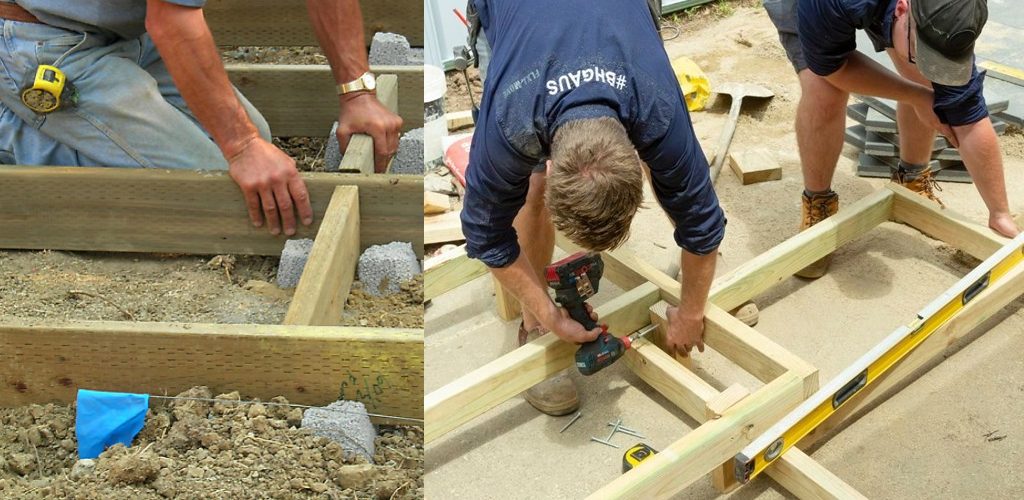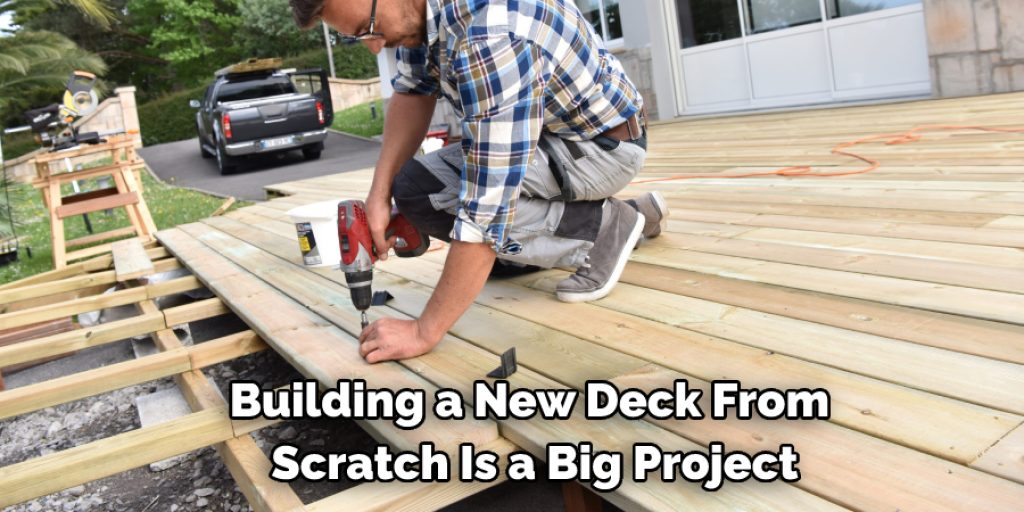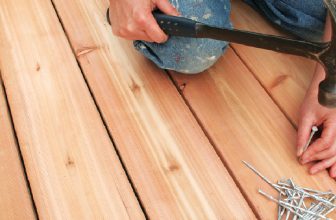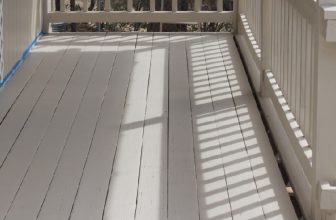How Far Out of Square Is Acceptable for a Deck
A deck is one of the most important parts of a home, providing valuable outdoor living space and often becoming a focal point for entertaining guests. While decks can vary greatly in size and shape, some general guidelines should be followed to ensure your deck is built safely and look its best. So, how far out of square is acceptable for a deck?

You should make sure your deck is no more than 1/8 out of square as a rule of thumb. This will ensure that your deck is level and stable. Any more than that, and you run the risk of having problems with your deck’s structure. Read on to know more!
What is a Square?
Before understanding how far out of square is acceptable for a deck, let’s define what square means in the context of the building. In simple terms, a structure is considered square when all four corners form perfect right angles. This can be achieved by using a carpenter’s square or by measuring the diagonals to ensure they are equal in length. A perfectly square deck will have all sides the same length and all corners at perfect right angles.
Why is Square Important for Decks?
Building a deck that is square is important for several reasons:
Structural Stability:
A square deck will distribute weight evenly, ensuring the structure can support the weight of people, furniture, and other items without causing stress on one side or corner.
Aesthetic Appeal:
A square deck is visually appealing and looks more professional. An out-of-square deck can look sloppy and unbalanced.
Ease of Building:
A deck that is perfectly square is easier to build as you can use the lines of the house and other structures as reference points. This will save time and effort during construction.
Necessary Considerations for Deck Squareness:

To ensure your deck is square, there are a few important things to keep in mind during the planning and construction process.
Foundation:
A strong and stable foundation is crucial for a square deck. The footings should be set correctly and evenly to create a solid base for the deck structure.
Measurements:
Accurate measurements are essential for achieving a square deck. Take the time to measure and mark all corners and lines accurately before starting construction.
Use of Tools:
Tools such as a carpenter’s square, level, and measuring tape are necessary for building a square deck. Make sure these tools are in good condition and used correctly to ensure accurate measurements.
How Far Out of Square Is Acceptable for a Deck: 10 Things to Consider
1. The Size of Your Deck:
The size of your deck will play a role in how far out of square it can be. A small deck may only accommodate a few inches of deviation from the square, while a larger deck can have more wiggle room. However, it is always better to strive for near-perfect squareness regardless of the size of your deck.
2. The Width of Your Deck:
The width of your deck also matters when it comes to how out of square it can be. A wider deck can usually accommodate more deviation, while a narrower deck might look awkward if it’s too far out of the square. Ideally, you’ll want to keep your deck within 1 inch of the square, but try to stay within 2 inches if that’s not possible. Anything more than that, and it will start to look visibly off-balance.
3. The Shape of Your Deck:
The shape of your deck also affects how out of square it can be. For example, a rectangular or square deck can tolerate more out of square than around deck. This is because the round deck already has less surface area in contact with the ground, so it is less forgiving of being out of the square.
4. The Type of Lumber You’re Using:
The type of lumber you’re using matters as well. Like oak or cedar, Heavier woods can handle being out of the square a bit more than lighter woods, like pine. If you’re using a mix of different types of lumber, try to make sure the heavier pieces are on the bottom and the lighter pieces are on the top. This will help distribute weight evenly and prevent the deck from becoming unbalanced.
5. The Location of Your Deck:
The location of your deck also makes a difference in how out of square it can be. For example, if your deck is in a shady area, it can tolerate more out of the square than if it’s in a sunny spot. This is because the sun will cause the wood to expand, so it’s important to consider that when designing your deck. Additionally, if your deck is built on uneven ground, it may be more challenging to achieve perfect squareness.
6. The Grade of Your Yard:
The grade of your yard matters as well. If your yard is on a slope, your deck will need to be square to keep it from looking off-balance. The sloped yard will create an uneven surface, which a deck cannot rest on. A deck that is not square will look like it is about to fall over. The steeper the slope, the more essential it is to have a square deck.

7. Your Budget:
Your budget is another important factor to consider when building a deck. The more complex and extravagant your deck design is, the more expensive it will be to build. If you are working with a limited budget, you may need to opt for a more simplistic deck design. This will also affect how out of square your deck can be, as more complex designs require a greater level of precision.
8. The Materials You’re Using:
The materials you’re using also play a role in how out of square your deck can be. For example, if you’re using pre-made decking or railing, making your deck perfectly square will be more difficult. On the other hand, if you’re using materials that you have to cut and fit yourself, you’ll have more control over the final shape of your deck. This means that you can afford to be a little less precise when making your deck square.
9. How to Level the Ground Is:
If the ground is not level, making your deck square will be more difficult. The uneven ground will cause your decking boards to be warped and bent. As a result, it will be more difficult to get them to fit snugly together. If the ground is very uneven, you may need to use shims to level out the surface before building your deck. This will also help make your deck more square.

10. The Design of the Deck:
The design of the deck is also a factor to consider. If you’re building a simple, rectangular deck, it will be easier to make it perfectly square than constructing a more complex, multi-level deck with lots of angles and curves. The more intricate the design, the harder it will be to achieve perfect squareness. However, with careful planning and precise measurement, it is still possible to build a square deck regardless of the design.
However, don’t get too hung up on making the deck perfect. A little bit of deviation from the square is generally acceptable and can even add to the character of your deck. Just make sure that the overall shape of the deck is still pleasing to the eye.
Tips for Accurate Square-Up Measurements:
Here, we have given answers on how far out of square is acceptable for a deck and some tips for getting accurate square-up measurements. Be sure to follow these tips.
1. Measure from the edge of the house to the edge of the deck.
2. Measure diagonally from one corner of the house to the opposite corner of the deck.
3. The deck is out of the square if the two measurements are different.
4. The amount that the deck is out of square equals half the difference between the two measurements.
5. To calculate the amount that the deck needs to be adjusted, divide the deck’s amount out of square by the diagonal measurement.
6. For example, if the deck is out of square by 2 inches and the diagonal measurement is 10 feet, the deck needs to be adjusted by 1/5 inch.
7. Use a level to mark the deck’s amount that needs to be adjusted.

How To Fix a Out Of Square Deck?
If your deck is out of the square, it is important to take steps to fix the problem as soon as possible. An out-of-square deck can be dangerous and can also decrease your home’s value. There are a few different ways that you can fix an out-of-square deck. Here we have given some of them.
1. Add Additional Framing:
If your deck is only slightly out of square, you may be able to fix the problem by adding additional framing. This is a relatively easy fix and a DIYer can do it. First, you will need to purchase some lumber, and then you will need to follow the instructions that come with your deck framing kit.
2. Make Adjustments to the Deck Joists:
If your deck is out of square by more than an inch, you may need to adjust the deck joists. This is a more complicated fix, and it is best left to a professional. First, you will need to remove the decking and adjust the joists.
3. Install New Decking:
If your deck is out of square by more than an inch and you cannot make adjustments to the joists, you will need to install new decking. This is a more difficult fix, and it is best left to a professional. First, you will need to remove the old decking and then you will need to install the new decking.
4. Replace the Deck:
If the deck is far from the square, it will need to be replaced. The new deck boards must be cut to fit and installed so that the deck is once again square. This may require some additional planning and carpentry skills.
5. Stain or Seal the Deck:
A newly constructed deck should be sealed or stained as soon as possible. This will help to protect the deck from the elements and keep it looking its best. Depending on the type of wood used to build your deck, you may need to seal or stain it every two years. When applying stain or sealer, follow the manufacturer’s instructions carefully.
Note: No matter which method you choose, it is important to fix an out-of-square deck as soon as possible. An out-of-square deck can be dangerous and can also decrease your home’s value.
How to Replace a Treated Wood Deck?
If your deck is made of treated lumber, you may eventually need to replace it. The lifespan of a treated wood deck varies depending on the type of treatment used but typically ranges from 10 to 15 years. When it’s time to replace your deck, the first step is to decide if you want to build a new one or replace the decking boards.
Building a new deck from scratch is a big project that will require some planning and design work. If you’re not up for that, you can save yourself some time and effort by simply replacing the decking boards. This is a much less invasive project that can be completed on a weekend.
Frequently Asked Questions:
Q: How Do You Square Up a Deck?
A: To square up a deck, measure from the edge of the house to the edge of the deck and then diagonally from one corner of the house to the opposite corner of the deck. If these two measurements are different, adjust accordingly by adding additional framing or making adjustments to the joists. You can also replace the decking boards or build a completely new deck if necessary. It is important to fix an out-of-square deck as soon as possible for safety and aesthetic reasons. You can also hire a professional for more complex fixes.
Q: How Far Out of the Square is Acceptable for a Deck?
A: Generally, it is acceptable for a deck to be slightly out of square as long as the overall design and shape are still aesthetically pleasing. However, if the difference between the two measurements mentioned above is significant, it may be necessary to make adjustments or replace the deck entirely. The amount that the deck is out of square should be no more than half the difference between the two measurements.
Q: How Often Should I Seal/Stain My Deck?
A: This depends on the type of wood used for your deck and the climate in which you live. As a general rule, it is recommended to seal or stain your deck every 2-3 years to protect it from the elements and maintain its appearance. However, some wood types may require more frequent maintenance. Always follow the manufacturer’s instructions when applying sealant or stain. It is also important to regularly inspect your deck for any signs of wear and tear and address any issues promptly to prolong its lifespan.
Q: Is Replacing a Treated Wood Deck Difficult?
A: The difficulty level of replacing a treated wood deck will depend on whether you choose to replace the entire deck or just the decking boards. Building a new deck from scratch can be a complex project that requires planning and design while replacing the decking boards is less invasive and can be completed in a weekend with some basic carpentry skills. It is always recommended to hire a professional for more complicated projects. It is also important to properly dispose of the old treated wood, as it may contain harmful chemicals. Check with your local waste management facility for proper disposal methods.
Overall, replacing a treated wood deck is not overly difficult but may require some time and effort. Always prioritize safety and seek professional help if needed.
Final Thoughts:
When a deck is not built perfectly square, certain deck areas will be under greater stress than others. This can lead to warping, splitting, and other damage over time. If your deck is just a bit out of square, you may be able to use fewer screws or nails to save on construction costs.
However, if the discrepancy is more pronounced, you’ll likely need to use more fasteners. Although it is possible to build a slightly out of the square deck, it is important to try and stay as close to the square as possible. This will help keep your deck looking nice and tidy for years to come.
If you are not comfortable measuring and calculating the angles yourself, be sure to hire a professional contractor who can do this for you. We hope after reading this guide you have gained some idea about how far out of square is acceptable for a deck. If you have any questions or want to know more, then feel free to comment below!
You can check it out to Fill Gaps in Wood Deck
You can check it out to Build 45 Degree Corner Deck Stairs




